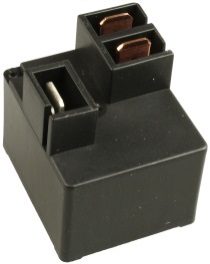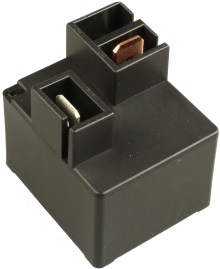RS-232 Relay Controller with 4 On-Board High-Power Relays
Highlights
- 1200/2400/9600/19.2K Baud Operation
- Power LED, Relay Status LEDs
- Control Status of All or Individual Relays
- Read Status of All or Individual Relays
- Two-Way Communication Capabilities
- Integrated Timer Functions
- E3C Compliance
- Programmable Relay Memory
- Optoisolated RS-232 Inputs
- 2 RS-232 Input Levels
- +12 Volt Operation, 2/3-Wire RS-232
- Overkill Transistor Drivers
- No-Click Power-up
- See Manual for Outline Dimensions
Pro Series Relay Control
Control All or Individual Relays with Two-Way Communication
Quick Start Kit Available for Easy RS232 Connection
Highly Reliable Relay Board For Demanding Applications
RS-232 Serial Relay Controller
Our RS-232 Relay Boards are fully E3C complaint, allowing up to 256 NCD devices to share a single RS-232 serial port. Mix and match up to 256 devices in any combination. Speak to each device individually or all devices at once. To control the this Relay Controller, simply connect a data and ground wire between the Relay Controller and computer or microcontroller. Provide +12 Volts DC to the board, and send ASCII character codes to control the relays. Even a no-frills design deserves a high-quality driver stage, and that’s exactly what we put on our Serial Relay Controllers. Fast-reacting flyback diodes help shunt dangerous voltages away from the driver circuit. Features include no-click startup, LED status lights, and E3C compliance. Relays can be controlled at 9600 baud and the board is compatible with ANY computer or microcontroller capable of delivering RS-232 data. Connect this board to the USB port of your computer using a USB to Serial adapter. The USB to Serial Adapter is to be used with the Quick Start Kit and is available at checkout.
NCD Component Library
Fully functioning programs for the Pro Series Controllers are included with the NCD Component Library. With the NCD Component Library we’ve “started” the programming for you. We say started because these are fully functioning samples but we’ve also included the source code so you can customize them to your exact needs. The NCD Component Library is a plug-in for the Visual Studio 2005/2008 that greatly simplifies the communications to the NCD product line. The samples can be run in Visual Studio and fully customized to your needs. Four different Pro Series samples are available including Relay Control, Read Status and Timing Features , to view screen shots of each sample visit our NCD Component Library Page. Start by downloading the FREE NCD Component Library and you will be communicating with any NCD device faster that ever!
The above sample demonstrates control and status read of up to 8 Relays. Compatible with all Pro (NOT ProXR) Series Relay Controllers, Including 4 and 8-Channel SPDT and DPDT Versions.
The above screen shot shows one of the four available fully functioning Pro Series samples that are available with the NCD Component Library. View all the examples on our NCD Component Library Page.
Associated Part Numbers
This product may have been previously manufactured using a part number shown below:
Relay Options

20-Amp SPDT High Power Relay Option
This controller is available with a 20-Amp relay option, allowing control of high-power loads up to an absolute maximum of 240VAC at 20 Amps. Ideal for high-power switching applications, this relay should never be used for low-power signals. The 20-Amp relay is of the SPDT variety, which provides Common (C), Normally Open (NO), and Normally Closed (NC) connections. Common is connected to NC when the relay is off. Common disconnects from NC and connects to NO when the relay is activated. This relay is Rated at 20-Amps between NO and C. Do not exceed 10-Amps between C and NC connections. This relay uses .250″ Quick Connect terminals (optional accessory) to connect to the top side of the relay. The relay is molded with COM, NC, and NO markings into the plastic. Review Datasheet

30-Amp SPST High Power Relay Option
This controller is available with a 30-Amp relay option, allowing control of high-power loads up to an absolute maximum of 240VAC at 30 Amps. Ideal for high-power switching applications, this relay should never be used for low-power signals. The 30-Amp relay is of the SPST variety, which provides Common (C) and Normally Open (NO) connections. Common has no connection when the relay is off. Common connects to NO when the relay is activated. This relay uses .250″ Quick Connect terminals (optional accessory) to connect to the top side of the relay. The relay is molded with COM, NO markings into the plastic. Review Datasheet
Wiring Diagrams
Essential
Tutorials
- Unable to Mount Virtual COM Port in Windows 10
- Controlling Inductive Devices: Managing Induction & Electromagnetic Interference
- Introduction to Computer Controlled Relays and Switching
- Relay Logic
Documentation Downloads
Download NCD Base Station
Introduction to Relay Control
This video will guide you in determining which relay controller you need for your application as well as a general overview of the differences between Relay Options. If you’re new to our products or just need a refresher for a new application this is a great place to start.
Induction Suppression
Learn about Induction and how it comes into play with Relay Controllers. Induction suppression can make your Relay Control applications intermittent and unreliable. This video will show you what causes it, how to avoid it, and how to account for it in your application.
Hiph-Power Relay Controller Specifications
This table covers all NCD High-Power Relay Controllers. All ratings assume 12VDC operation at 70°F (21°C). Please note that most ratings are estimated and may be subject to periodic revision. Some ratings represent stock controller settings without performance enhancement optimizations. The estimated processing time can be impacted by background services and choice of commands. Standby power consumption assume no communications module is installed and no relays are active on the controller. Please add the power consumption of the activated relays and communications module to obtain a better estimation of power consumption.| Specifications of NCD SPDT Relay Controllers | Minimum | Nominal | Maximum | Notes |
|---|---|---|---|---|
| Operational Voltages | 10VDC | 12VDC | 15VDC | |
| Standby Power Consumption | 35mA | 100mA | 200mA | No Active Relays, No Com Module |
| Relay Power Consumption | 28mA | 35mA | 60mA | Consumption of Each Activated Relay |
| Operational Temperature Range | -40°F (-40°C) | 70°F (21°C) | 185°F (85°C) | Theoretical Component Limits Shown |
| Storage Temperature Range | -67°F (-55°C) | 70°F (21°C) | 185°F (85°C) | Theoretical Component Limits Shown |
| Operational Ambient Air Humidity | 0% | 50% | 70% | Non-Condensing Humidity Values Shown |
| Relay Activation Time | 15ms | Component Rating Shown | ||
| Relay Deactivation Time | 10mS | Component Rating Shown | ||
| Operational Life Mechanical | 10,000,000 | Component Operation Rating | ||
| Operational Life Electrical | 100,000 | Component Rating at Maximum Load |
RS-232 Serial Compatibility Notes
The NCD RS-232 Serial communications module is compatible with standard RS-232 signals (+/-10VDC), which are not directly compatible with UART signals from a microprocessor. If you are working with Arduino, Microchip PIC, or other common microcontroller, a communications module is not required. Microcontrollers will directly talk to the on-board processor of all NCD controllers.


